“Only Artists Were Not Fooled”: Delacroix’s Preparatory Drawings on Tracing Paper
by Ashley E. DunnAshley E. Dunn is an associate curator in the Department of Drawings and Prints at the Metropolitan Museum of Art, where she is responsible for nineteenth-century French drawings, prints, and illustrated books. She curated Devotion to Drawing: The Karen B. Cohen Collection of Eugène Delacroix and wrote the accompanying catalogue, Delacroix Drawings: The Karen B. Cohen Collection (2018). She received her PhD in art history from Northwestern University, where she wrote her dissertation on etching as a modern medium for representing Parisian urban space in the nineteenth century.
Email the author: Ashley.Dunn[at]metmuseum.org
Citation: Ashley E. Dunn, “‘Only Artists Were Not Fooled’: Delacroix’s Preparatory Drawings on Tracing Paper,” Nineteenth-Century Art Worldwide 21, no. 2 (Summer 2022), https://doi.org/10.29411/ncaw.2022.21.2.3.
This work is licensed under a Creative Commons Attribution-NonCommercial 4.0 International License  unless otherwise noted.
unless otherwise noted.
Your browser will either open the file, download it to a folder, or display a dialog with options.
As an artist who worked across media throughout his career, Eugène Delacroix (1798–1863) developed extraordinary dexterity in moving between drawings, prints, and paintings. His own definition of printmaking centered on this skill of translation: “Printmaking is a true translation,” he wrote, “that is to say, the art of transporting an idea from one art form to another.”[1] At the center of this process, tracing paper served as an indispensable tool for the artist.
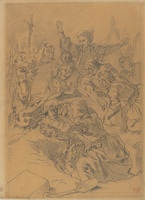
In his entry on a graphite drawing on tracing paper preparatory to the lithograph Hamlet and Laertes at the Tomb of Ophelia (fig. 1), Alfred Robaut (1830–1909), coauthor of the 1885 catalogue raisonné of Delacroix’s oeuvre, noted:
Delacroix enjoyed tracing his compositions several times, and the more he advanced, the more he simplified, striving to render in ten strokes of the pencil, instead of a hundred, what he had initially expressed. One cannot overemphasize this point, ignored at the time of the sale, which meant that the master’s most beautiful drawings were neglected for the most part at auction because they were on tracing paper. Only artists were not fooled.[2]
The sale Robaut refers to was the posthumous auction of the contents of Delacroix’s studio, which took place in 1864.[3] The red estate stamp at the lower right of the Hamlet and Laertes sheet confirms that this drawing indeed passed through that sale. According to Robaut’s commentary, Delacroix’s drawings on tracing paper were largely passed over due to their medium or, more specifically, their support. It was only fellow artists who recognized the value of these works as a vital part of his creative process. Robaut credits himself as being among those discerning artists, as he was actually the astute collector who acquired this drawing at the auction. But his insightful remarks notwithstanding, the general neglect of the drawings on tracing paper continues to this day. Throughout the twentieth and into the twenty-first century, these works have received little scholarly attention. Their disregard raises questions about conceptions of artistic process and originality in the nineteenth century and today.
When confronted with a drawing on tracing paper, is the viewer necessarily correct to assume that it replicates another work? Beyond a means of simple transfer, what role did tracing paper play for Delacroix? And how do the drawings on tracing paper relate to his work in other media? This essay explores Delacroix’s use of the transparent support to prepare his lithographs and wood engravings in order to demonstrate the integral role of his drawings on tracing paper in the creative development and translation of his ideas into print.
With industrialization and the increase in production of machine-made papers, tracing paper became more widely available in the nineteenth century.[4] Delacroix, like many artists of his time including his rival Jean-Auguste-Dominique Ingres (1780–1867), employed the transparent sheets for many different purposes throughout his career.[5] A key stage of increased frequency in his use of the support to prepare work in other media occurred in the early 1840s, when he was completing his most ambitious public mural commission: the decoration of the new library in the Palais Bourbon, seat of the French National Assembly. Among the surviving drawings related to this project, a considerable number are on tracing paper. The monumental scale of the program, which involved five cupolas with four pendentives each, and two cul-de-fours or half-domes, required him to hire assistants.[6] This explains in part his need for more exacting drawings than the ones he created when he worked, on his own, to execute his prior Palais Bourbon commission for the Salon du Roi. Tracing paper enabled an iterative process that helped the artist to develop and clarify his ideas before giving instructions to his primary collaborators.[7]
Two versions of The Tribute Money, a design for the cupola devoted to theology, demonstrate Delacroix’s process of refinement using tracing paper (figs. 2, 3). Compositionally, the two drawings are very similar; both show one of the miracles of Jesus in which the apostle Peter, in the foreground at left, retrieves payment for the temple tax from the mouth of a fish (Matthew 17:24–27). Delacroix likely used a preliminary compositional sketch as the basis for these drawings, although such a sheet is unlocated. The major difference between the two is the presence of a young boy seen from behind in the foreground at right in the drawing from the Karen B. Cohen collection held at the Metropolitan Museum of Art in New York. By including the boy, the artist possibly intended to show the three ages of man as witnesses to the miracle, progressing counterclockwise from the youth to the adult fisherman to his right, then to the old man whose head appears at center. Delacroix eliminated the boy in the drawing at the Musée du Louvre, which corresponds to the arrangement of the mural in situ. Delacroix wrote in his Journal about the distillation achieved by tracing as a “process of idealization”: “[It] happens almost without my realizing it whenever I make a tracing of a composition that comes out of my head. The second version is always corrected and brought closer to the necessary ideal.”[8] In this case, it seems Delacroix determined that the figure of the boy distracted from the clarity of the narrative. With his removal in the Louvre drawing, the artist draws the viewer’s attention more emphatically to Peter and the discovery of the tribute money. By iterating and altering his design through tracing, Delacroix arrived at the final composition.
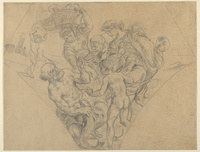
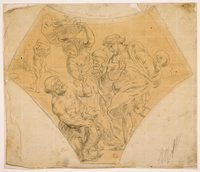
Michel Urtado.
The intersection of Delacroix’s mural commissions with a major print project may account for his increasing use of tracing paper to prepare his lithographs. In 1834, the artist began his series of sixteen lithographs illustrating Shakespeare’s Hamlet, preparing at least six stones by the following year.[9] He then put the prints on hold, probably due to the demands of completing the decorative schemes for the Palais Bourbon and the Palais du Luxembourg. He returned to them again finally in 1842 to complete ten additional designs, and selected thirteen for the 1843 publication. The surviving preparatory drawings for Hamlet show how he adapted the utility of tracing paper for designing murals to printmaking.[10]
Hamlet and Laertes at the Tomb of Ophelia (see fig. 1) represents act 5, scene 1, in which Ophelia’s brother, Laertes, blames Hamlet for her death, and the two end up fighting at her gravesite.[11] The wide-eyed expressions of the gathered crowd, crowned by Hamlet’s friend, Horatio, with his arms flung wide, serve to heighten the emotion of the struggle between the protagonists. In addition to the drawing on tracing paper, another preparatory drawing of the full composition for this lithograph exists. It is executed in a looser, sketchier manner, although certain contours are reinforced with harder, more definitive lines (fig. 4). Upon first seeing the two drawings side by side, one might assume that the drawing on tracing paper was directly traced from the looser sketch. However, a digital overlay (fig. 5) of the two works shows that the Metropolitan Museum of Art drawing is far from a straightforward tracing.[12] Examining a detail of the overlaid image (fig. 6) makes it easier to distinguish the differences between the sketchier drawing in blue and the Metropolitan Museum drawing on tracing paper in red and to understand Delacroix’s intentions in using this material. The upper half of the composition reveals how Delacroix shifted elements between the two drawings. Horatio’s arm is raised higher, his hat is taller, and the priest on the left is moved lower on the sheet of tracing paper. He also inserted a new attendant figure: a young boy between the priest and Horatio. Without enumerating all the differences here, it is clear that the Metropolitan Museum drawing is not an instance of direct tracing but rather another stage in the development of the composition. This example supports Delacroix’s own description of his use of tracing paper as well as Robaut’s: tracing enabled the artist to hone his composition through repetition with adjustments, so that when it came time to draw the design on the lithographic stone, his task was clear and defined. However, this careful planning was a starting point that did not prevent him from continuing to make adjustments on the lithographic stone. Most notably, he eliminated the rightmost figure from the lithograph (fig. 7).[13] The removal of this extraneous figure recalls the elimination of the boy during the process of refining The Tribute Money and similarly serves to adjust the visual emphasis of the composition, in this case shifting attention in the lithograph more toward the figures of Hamlet and Laertes locked in combat.
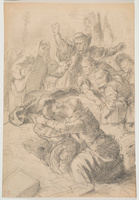
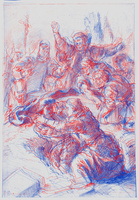
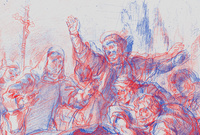
Chris Heins.
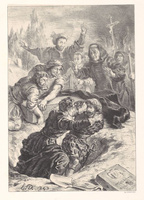
Lithography was not the only print technique that Delacroix engaged with in 1842. He was also involved in the more widespread medium of wood engraving, and found tracing paper equally useful in this process. Among Delacroix’s prints, wood engravings have largely been ignored.[14] Although his nineteenth-century cataloguers, Adolphe Moreau (1827–82) and Robaut, included wood engravings in their catalogues raisonnés, Loys Henri Delteil (1869–1927)—whose 1908 volume forms the basis for the standard reference on the artist’s prints today—omitted them.[15] In the context of cultivating the identity of the “painter-printmaker,” the division between “original” and “reproductive” prints became increasingly codified in the early twentieth century, to the point that a print only could be deemed original when the artist had a direct hand in producing the matrix.[16] This definition cannot be reconciled with nineteenth-century wood engraving practices.
Wood engraving was a highly specialized trade that involved years of apprenticeship.[17] Unlike with lithography, painters rarely participated directly in the creation of the printing matrix beyond supplying a drawing to the workshop, where an intermediary draftsman copied it onto a block before an engraver incised it. Wood engravers often signed their names to the block in addition to including the signatures of the artist or designers. The uncertainty or misconception of Delacroix’s relationship to the matrix of his wood engravings has left them overlooked.[18] By examining his drawings for wood engravings—many of which are on tracing paper—and the textual evidence of his involvement, a case emerges for reintegrating these prints into his oeuvre.
In January 1842, the popular illustrated weekly Le Magasin pittoresque published an article by Delacroix recounting his recollections of a Jewish wedding in Morocco, the subject of a painting he had submitted to the Salon the previous year (fig. 8). An editor’s note states that the magazine had intended to publish a reproduction of the painting but was only able to procure a drawing of the musician from the artist (fig. 9).[19] A drawing on tracing paper in the Cohen collection appears to be that which the artist submitted to the magazine (fig. 10). Comparing the drawing with the painting shows that Delacroix chose not to copy the figure exactly but rather made slight adaptations for the publication. He shifted the musician’s gaze from directly outward to sidelong, adjusted the volume and fall of the drapery over his shoulders, revealed his crossed legs, and added the accessories of the tambourine and cushion on either side. The engraving of the woodblock was entrusted to the firm of Andrew, Best, and Leloir—inscribed above the date at lower right—a leading workshop of wood engravers established in 1832.[20] The survival of the drawing of the Jewish Musician suggests that, as was common practice, an intermediary draftsman likely manually copied Delacroix’s drawing onto the woodblock before it was engraved, rather than affixing it directly to the block and destroying it in the process of engraving.
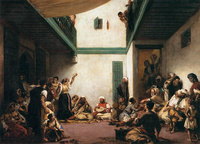
Stéphane Maréchalle.
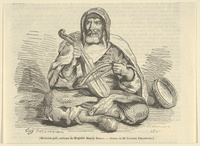
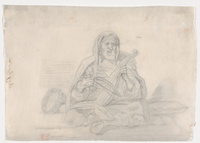
Museum of Art.
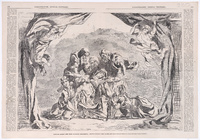
Other wood engravings by or after Delacroix suggest different working processes. Just two weeks after the artist’s death, L’Illustration published his Pietà (fig. 11), a composition related to his mural in the Church of Saint Denis du Saint Sacrement in Paris. The caption refers to the work as Delacroix’s “last drawing on wood” (or last wood engraving), and it accompanied an article by the critic Alfred Darcel (1818–93) titled “Les Dessins sur bois d’Eugène Delacroix” (Delacroix’s Drawings on Wood).[21] Although the term dessin sur bois was used occasionally in the nineteenth century to refer to wood engraving in a general sense along with the more common gravure sur bois, here, I would like to seriously consider the more literal translation of “drawing on wood” because of the argument Darcel puts forth in his article.[22]
To describe a wood engraving as a drawing of any sort troubles today’s common interpretations of these two media, in particular their proximity to the artist’s hand. Wood engraving is typically characterized as highly mediated and at a remove from the artist due to the translation of the drawing by another hand onto the woodblock before it is engraved by yet another practitioner. Drawing, in contrast, is credited as one of the most immediate and intimate forms of artistic expression.[23] So how do we make sense of Delacroix’s so-called drawings on wood? According to Darcel,
Delacroix wanted to see if wood engraving could, not translate, but render his thought. So he did not entrust his sketches to the free interpretation of intermediary draftsmen, whose marks the engraver then cuts as he pleases. Rather, he drew on the wood himself, extensively, in broad, fluid strokes of the pen, guided by his creativity in the moment; and the engraver had only to reserve in the wood the lines that the master had vigorously left there.[24]
Darcel proposed that by forgoing one of the intermediaries and drawing directly onto the wood himself, Delacroix considered the medium of wood engraving capable of directly conveying his creative thought. This raises a number of questions: How do we then interpret the resulting print in relation to drawing? In the absence of the woodblock itself, which retained the drawing, could one interpret the wood engraving as a kind of record of a drawing on wood?
The understanding that Delacroix drew on wood appears elsewhere in the nineteenth-century literature. Robaut states plainly, “Tradition has it that Delacroix drew on the wood himself.”[25] More specifically, Robaut’s entries on four wood engravings published by Le Magasin pittoresque in 1845 emphasize that they were “engraved on wood on a drawing by the master.”[26] The four subjects derive from Johann Wolfgang von Goethe’s (1749–1832) Goetz von Berlichingen (1773) that, like Hamlet, preoccupied Delacroix over a long period.[27] He also created seven Goetz lithographs, though he never published them as a suite. The anonymous article that accompanied the wood engravings in the magazine described them as “four sketches that he made on wood for us”[28] (figs. 12–15).
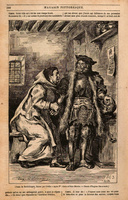
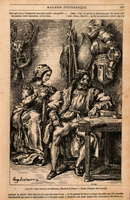
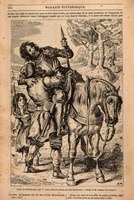
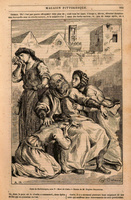
Delacroix’s own references to wood engraving are scarce but revealing. In March 1842, he noted that he was “busy arranging drawings in the format of Le Magasin pittoresque for the woodblocks that I want to make.”[29] Although he does not expressly state here that he drew on the woodblock, his comment conveys his awareness that producing a drawing for engraving and publication required certain formal characteristics. The drawings for the wood engravings, such as The Wounded Goetz Taken In by the Gypsies (fig. 16), are executed on tracing paper and show how Delacroix translated his graphic syntax to suit the print medium or, as he put it, “the format of Le Magasin pittoresque.”
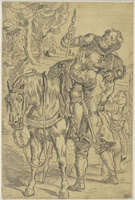
The specificity of his graphic approach to wood engraving is especially clear when one compares it with drawings for lithographs of the same subject. The drawings for the lithographs vary in style from tonal to linear. The only surviving drawing for The Wounded Goetz lithograph, for example, is executed loosely in brown-and-blue wash (fig. 17), whereas the drawing for Friar Martin Clasping Goetz’s Gauntlet has a more calligraphic quality with its free-flowing pen-and-ink lines over graphite with almost no shading whatsoever (fig. 18). By contrast, the drawings for the wood engravings are composed of clearly defined contours and organized hatching. Eugène Bouvy, in the only article devoted to this subject, describes the interest of the wood engravings themselves as residing “in their facture, in their drawing, executed with thick lines . . . vigorous, abrupt, intentionally summary” and suitable to their interpretation of scenes from the Middle Ages.[30]
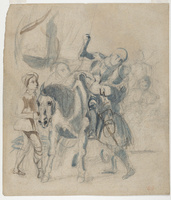
Museum of Art.
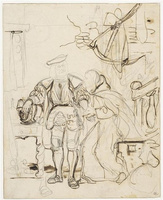
Delacroix conveyed slightly more about the material preparation of these wood engravings in a letter of June 1842. “I feel like making Charton’s woodblocks,” he wrote from George Sand’s (1804–76) home in Nohant to his dear friend Jean-Baptiste Pierret back in Paris. Édouard Charton (1807–90) was the editor of Le Magasin pittoresque. Delacroix asked Pierret to “place in a box the two woodblocks that remain at the house, plus the three drawings that remain to do, plus a sheet or two of tracing paper that you can fold in quarters, which is necessary for tracing.”[31] That two woodblocks were in Delacroix’s possession confirms, I believe, that in the case of the Goetz wood engravings, he most likely did draw directly on the wood.[32] The passage also affirms that tracing paper remained a vital part of his process, undoubtedly helping with the reversal required when executing the design on the woodblock.
Ultimately, Darcel’s testimony in L’Illustration regarding Delacroix’s direct work on the block for the Pietà is undermined by Delacroix in his Journal. However, these same passages demonstrate again the fundamental role of his drawings on tracing paper: on October 3, 1854, he noted that he had “delivered this morning to M. [Alexandre] Pothey, wood engraver, the drawing on tracing paper of Christ at the Tomb from Saint-Denis du Saint-Sacrement.”[33] Eight months later, he reminded himself to ask Pothey again for the tracing of Christ from Saint Denis du Saint Sacrement, indicating that he had at least once previously asked for the return of the drawing.[34] These statements make clear that for the Pietà wood engraving, Delacroix, in fact, provided a drawing on tracing paper for Pothey to copy onto the woodblock rather than drawing on it himself.[35] Despite disproving Darcel’s claims of immediacy in this case, the argument he puts forth for Delacroix drawing directly on the woodblock bears out in the Goetz prints. By turning attention to Delacroix’s use of tracing paper to prepare his prints, his understudied wood engravings come to the fore and assert their place among his original prints.
Delacroix scholars and those interested in artistic process in the nineteenth century should no longer be fooled when considering a drawing by the artist on tracing paper. These works are rarely simple copies. As Robaut advocated in 1864, Delacroix’s drawings on tracing paper merit serious consideration if we are to understand the methods by which the artist advanced his designs. There is still considerable research to be done on the role of tracing in preparing his paintings on canvas. The drawings related to lithographs and wood engravings studied here reveal the evolution of the artist’s ideas through tracing and its fundamental role in developing and translating his compositions into prints.
Notes
All translations are by the author unless otherwise indicated.
[1] “La gravure est une véritable traduction (voyez Traduction), c’est-à-dire l’art de transporter une idée d’un art dans un autre.” This definition appears as part of the dictionary of fine arts that Delacroix drafted in his Journal. Above the dictionary heading for “Gravure” he specified: “Lithographie/eau-forte,” clarifying that his definition applies to printmaking broadly and not engraving specifically. Eugène Delacroix, Journal, ed. Michele Hannoosh (Paris: José Corti, 2009), 1:1085–86, entry of January 25, 1857. For more on the semiotics of Delacroix’s creative translation, see Ségolène Le Men, “Delacroix et l’estampe,” in Delacroix, ed. Sébastien Allard and Côme Fabre, exh. cat. (Paris: Musée du Louvre, 2018), 375–83.
[2] “Il est à remarquer, d’ailleurs, que Delacroix se plaisait à calquer plusieurs fois ses compositions et plus il avançait, plus il simplifiait, s’efforçant de rendre en dix coups de crayon, au lieu de cent, ce qu’il avait d’abord exprimé. On ne saurait trop insistait sur ce point ignoré au moment de la vente, ce qui fit que les plus beau des dessins du maître furent la plupart du temps délaissés aux enchères, parce qu’ils étaient sur papier calque. Les artistes seuls ne s’y laissaient pas prendre.” Alfred Robaut, Fernand Calmettes, and Ernest Chesneau, L’Oeuvre complet de Eugène Delacroix: Peintures, dessins, gravures, lithographies (Paris: Charavary, 1885), no. 755. Emphasis added.
[3] Catalogue de la vente qui aura lieu par suite du décès de Eugène Delacroix, auction cat. (Paris: Hôtel Drouot, 1864).
[4] On the history of tracing paper, see Claude Laroque, “History and Analysis of Transparent Papers,” The Paper Conservator 28, no. 1 (2004): 17–32, https://doi.org/10.1080/03094227.2004.9638639.
[5] For more on Delacroix’s other uses of tracing paper, including his support of its utility in learning to draw; as a method of recording his own drawings; and even as the support for presentation oil sketches, see Ashley E. Dunn, “Delacroix as a Draftsman: Through the Lens of the Karen B. Cohen Collection,” in Delacroix Drawings: The Karen B. Cohen Collection, exh. cat. (New York: Metropolitan Museum of Art, 2018), 16, 29, 44.
[6] On the murals for the National Assembly, see Arlette Sérullaz and Nicole Moulonguet, Eugène Delacroix à l’Assemblée nationale, exh. cat. (Paris: Assemblée Nationale, 1995); and David O’Brien “Civilization and Mural Painting” and “Appendix: The Paintings of the Library of the Bourbon Palace,” in Exiled in Modernity: Delacroix, Civilization, and Barbarism (University Park, PA: Penn State University Press, 2018), 41–74, 155–82.
[7] Delacroix hired Gustave Lassalle-Bordes and Louis de Planet to assist with the Chamber of Deputies Library commission. Planet’s published recollections include references to Delacroix transmitting his designs via tracing. See Louis de Planet, Souvenirs de travaux de peinture avec M. Eugène Delacroix, ed. André Joubin (Paris: A. Colin, 1929). For more on Delacroix’s studio practices when preparing his mural projects, see David O’Brien, “Peinture murale et atelier du peintre,” in Dans l’atelier, la création à l’oeuvre, ed. Dominique de Font-Réaulx, exh. cat. (Paris: Musée du Louvre, 2019), 43–55.
[8] “Ce travail d’idéalisation se fait même presque à mon insu chez moi, quand je recalque une composition sortie de mon cerveau. Cette second edition est toujours corrigée et plus rapprochée d’un ideal necessaire.” Delacroix, Journal, 1:688, entry of October 12,1853.
[9] Unlike the illustrations for Goethe’s Faust, which were commissioned by the publisher Charles Motte, the Hamlet project seems to have been self-motivated. François Villain printed the lithographs at Delacroix’s expense. See Loys Delteil, Delacroix: The Graphic Work; A Catalogue Raisonné, ed. and trans. Susan Strauber (San Francisco: Alan Wofsy Fine Arts, 1997), 251n256.
[10] In addition to Hamlet and Laertes at the Tomb of Ophelia discussed in the essay, other examples of Hamlet drawings on tracing paper include Ghost on the Terrace (1834; Detroit Institute of Arts); Hamlet and Guildenstern (1834–43; Musée du Louvre, Paris); Alas! Poor Yorick! [for the lithograph Hamlet and Horatio before the Gravediggers] (ca. 1843; Metropolitan Museum of Art, New York); and The Death of Hamlet (ca. 1843; Metropolitan Museum of Art, New York).
[11] For more on Delacroix’s treatment of this scene across different media over time, see Sébastien Allard and Côme Fabre, “The Sphinx of Modern Painting,” in Delacroix, ed. Sébastien Allard and Côme Fabre, exh. cat. (New York: Metropolitan Museum of Art, 2018), 158−63; and Robert I. Edenbaum, “Delacroix’s ‘Hamlet’ Studies,” Art Journal 26, no. 4 (1967): 340–73, https://www.jstor.org/.
[12] Thank you to Chris Heins, imaging specialist at the Metropolitan Museum of Art, for creating the digital overlay.
[13] This print was one of the three omitted from the 1843 publication of Hamlet. It was eventually included in a posthumous edition of the book published in 1864.
[14] One exception is Eugène Bouvy, “Quatre bois d’Eugène Delacroix,” L’Amateur d’estampes 12 (1933): 33–43, https://gallica.bnf.fr/.
[15] Adolphe Moreau distinguished between a list of seventeen “original” wood engravings by the artist and more than sixty reproductions in wood engraving in E. Delacroix et son oeuvre (Paris: Librairie des Bibliophiles, 1873). Robaut’s catalogue, which integrated paintings, drawings, and prints in a chronological presentation, lists certain wood engravings as drawings, but in the case of others specifies dessin sur bois. See Delteil, Delacroix: The Graphic Work.
[16] On Delacroix’s interest in and involvement with reproductive prints, see Stephen C. Pinson, “Reproducing Delacroix,” Visual Resources 14, no. 2 (1998): 155–87; and Sophie Bobet-Mezzasalma, “Delacroix et l’estampe d’interprétation,” Nouvelles de l’estampe, no. 157 (March 1998): 23–88. On the development of the definition of the “original print,” see Pat Gilmour, “On Originality,” Print Quarterly 25, no. 1 (2008): 36–50, http://www.jstor.org/.
[17] See Remi Blachon, La Gravure sur bois au XIXe siècle: L’Âge du bois debout (Paris: Les Éditions de l’Amateur, 2001).
[18] In his chapter “Original Wood Engraving,” Blachon notes that Delacroix was an exception among ninteenth-century painters for his interest in the medium: “Les peintres ne s’étaient d’abord que peu intéressés au nouveau procédé. Toutefois, Eugène Delacroix . . . a réalisé plusieurs dessins sur bois qui sont loin d’être négligeables—même s’ils sont généralement négligés par les très nombreux d’auteurs que se sont intéressés au maître romantique.” Blachon, La Gravure sur bois, 178.
[19] “Notre intention était de publier une gravure du tableau de la Noce juive . . . mais l’auteur n’a pu nous procurer que ce dessin d’un musicien.” “Une Noce juive dans le Maroc,” Le Magasin pittoresque, January 1842, 28, https://gallica.bnf.fr/.
[20] Blachon, La Gravure sur bois, 64, 195.
[21] Alfred Darcel, “Les Dessins sur bois d’Eugène Delacroix,” L’Illustration, August 29, 1863, 151–54.
[22] Adolphe Moreau, for example, used dessin sur bois in his catalogue E. Delacroix et son oeuvre.
[23] For a discussion of the evolution of the conception of drawing in France, including the perception of the medium as “the most revealing manifestation of artistic individuality,” see Ewa Lajer-Burcharth, “Drawing: Medium, Discourse, Object,” in Drawing: The Invention of a Modern Medium, ed. Ewa Lajer-Burcharth and Elizabeth Rudy, exh. cat. (Cambridge, MA: Harvard Art Museums, 2017), 12−15.
[24] “Eugène Delacroix voulut essayait si la gravure sur bois pourrait, non pas traduire, mais rendre sa pensée. Car il ne confia point ses croquis à la libre interprétation des metteurs sur bois, dont le graveur taille les indications à sa guise. Il dessina lui-même sur le bois, largement, par touches heurtées d’une plume épaisse et baveuse, suivant la fantaisie du moment; et le graveur n’eut plus qu’à réserver dans le bois les traits que le maître y avait vigoureusement écrits.” Darcel, “Les Dessins sur bois,” 152. Emphasis added.
[25] “Il est de tradition que Delacroix dessina lui-même le bois.” This appears under the entry for the first wood engraving in his catalogue, which notably he described as a drawing. Robaut, Calmettes, and Chesneau, L’Oeuvre complet, no. 327.
[26] “gravé sur bois sur un dessin du maître.” Robaut, Calmettes, and Chesneau, L’Oeuvre complet, no. 640. Emphasis added.
[27] Goethe’s Goetz von Berlichingen was published in French translation in 1823. The following year, Delacroix noted his desire to make sketches based on the story of the late medieval German knight, and in an 1827 sketchbook (fol. 25, verso, RF9105, Département des Arts Graphiques, Musée du Louvre, Paris) he listed seven possible subjects, including “Goetz arrives wounded on his horse among the gypsies.” Delacroix, Journal, 1:124, entry of February 28, 1824.
[28] “quatre esquisses qu’il a faites sur bois à notre intention.” Anonymous, “Goetz de Berlichingen à la main de fer,” Le Magasin pittoresque, April 1845, 139, https://gallica.bnf.fr/.
[29] “Je m’occupe aussi à arranger des dessins dans le format du Magasin pittoresque pour les bois que je veux faire.” Letter from Delacroix to Jean-Baptiste Pierret, March 12, 1842, in Correspondance générale d’Eugène Delacroix, ed. André Joubin (Paris: Plon, 1945), 2:93, 106−9.
[30] Bouvy, “Quatre bois,” 43.
[31] “Je me sens en train de faire les bois de Charton. Tu vois d’ici que j’ai recours a toi pour l’exécution de tout ceci. . . . D’abord il s’agirait de mettre dans une boîte quelconque les deux bois qui restent à la maison; plus les trois dessins qui restent à faire; plus une feuille de papier végétal ou deux que tu plieras en quatre, et qui sont nécessaires pour calquer.” Letter from Delacroix to Jean-Baptiste Pierret, June 7, 1842. Delacroix, Correspondance, 2:107.
[32] Eugène Bouvy arrived at the same conclusion based on the text in Le Magasin pittoresque alone. Bouvy, “Quatre bois,” 38.
[33] “Remis ce matin à M. Pothey, graveur sur bois, le dessin sur papier végétal du Christ au tombeau, de Saint-Denis du Saint-Sacrement.” Delacroix, Journal, 1:846, entry of October 3, 1854.
[34] “Redemander à Pothey le calque du Christ de Saint Denis du Saint-S[acremen]t.” Delacroix, Journal, 1:901, entry of May 27, 1855.
[35] A drawing at the Musée du Louvre has been connected with Pothey’s engraving; however, the composition excludes the angels that appear in the wood engraving. See Christophe Léribault, Une Passion pour Delacroix: La Collection Karen B. Cohen, exh. cat. (Paris: Musée Nationale d’Eugène Delacroix, 2009), 42–44.